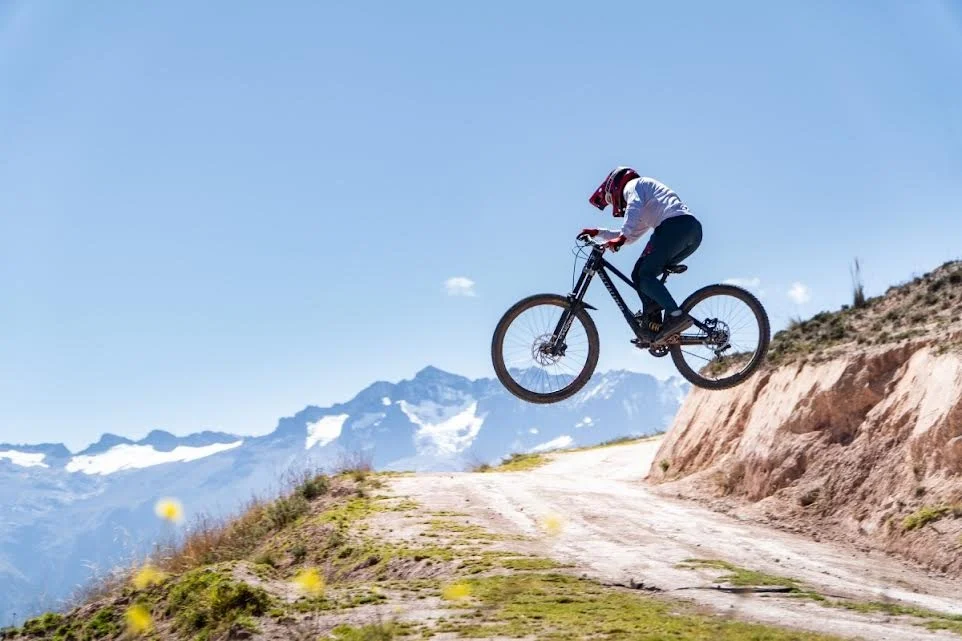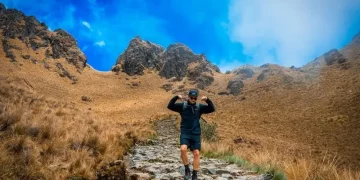Your body feels the change immediately at 11,150 feet above sea level. Every pedal stroke demands extra effort, the air thins out, and a gentle slope becomes a real challenge. Your muscles cry out for oxygen and your heart rate jumps without warning.
Cusco sits deep in the Andean mountain range, former capital of the Tahuantinsuyo. Its main appeal for mountain bikers lies in the trails that cross the region. Paths built over 500 years ago by pre-Columbian cultures, still used today by communities that speak Quechua as their everyday language.
Adapting to altitude
The city sits at 11,150 feet. To put that in perspective: Mexico City reaches 7,350 feet, Denver hits 5,280, and most cities worldwide stay below 1,640 feet. Physical adaptation isn’t optional.
Initial symptoms appear quickly: moderate headache, general fatigue, and shallow breathing. Altitude sickness affects virtually all visitors coming from lower elevations. The strategy is straightforward: minimum 48 hours of rest before any demanding activity. Constant hydration, light meals, and quality sleep. Within two days, your body reaches sufficient acclimatization.
Nearby trails climb to passes exceeding 13,120 feet, reaching 16,400 if you venture deeper into the range. Elevations matching or surpassing the highest peaks in Western Europe, then plunging into deep valleys.
These routes are over 700 years old, built by the Tahuantinsuyo, a civilization that connected much of South America without wheeled transport, without the wheel itself, and without a writing system. They developed a stone road network linking urban centers, ceremonial sites, fortifications, and rural settlements across thousands of miles.
Those roads remain operational. Local inhabitants travel them on foot or with llama caravans, moving goods between villages. Cyclists seek them out for their technical demands, visual impact, and engineering that has withstood centuries.
What is mountain biking?
If you’ve never tried this sport, think of bicycles designed specifically for rough terrain. These aren’t city bikes or road bikes. They have wide tires with deep tread, suspension systems that absorb impacts, powerful brakes, and reinforced frames. They’re built to roll over rock, dirt, roots, and steep slopes.
Mountain biking combines physical endurance with technical skill. It’s not just about pedaling hard, but reading the terrain, controlling speed on descents, and maintaining balance through tricky sections. In the Andes, you add the altitude factor, multiplying the challenge.
Distinct seasons
The region has two clearly defined periods. From May to October extends the dry season: clear skies, solid trails, and excellent visibility. Snow-capped mountains appear in the distance during fast descents. This is the optimal period for mountain biking.
From December to March, rainfall turns trails into muddy corridors. Technical routes become risky, the ground deteriorates, and numerous operators suspend outings to preserve both rider safety and environmental integrity. Anyone traveling during this season should expect alternative options or extended delays.
Three descents to understand the Andes
Yuncaypata: Your first ride
Three miles of gentle descent from 12,350 to 10,925 feet. Perfect for acclimatizing and feeling how the bike responds on packed dirt with loose stones. You pass through eucalyptus forests and rural areas. It’s accessible and doesn’t intimidate.
Abra Málaga: The complete descent
Thirty-one miles of almost continuous downhill from 14,160 to 9,200 feet. This is the famous route. You start with intense cold in high puna and finish in subtropical weather. You cross three different ecosystems in a single descent. It demands technique and control, but you don’t need to be a pro. It’s long, varied, and visually stunning.
Lares Trail: Inside Andean life
Seven and a half miles from 15,090 to 9,500 feet. You pass through communities where Quechua is the daily language and agricultural terraces still produce potatoes, corn, and quinoa. The trail alternates fast descents with rocky stretches where it’s smart to dismount. Here you feel like you’re pedaling through a living territory.
Territory with living identity
In Andean worldview, mountains are sacred entities called Apus, guardians of communities. People present offerings to them, hold ceremonies tied to agricultural cycles, and make territorial decisions considering this spiritual relationship with the landscape.
Riding these trails means traveling through spaces where this understanding remains active. Terraces function as productive units, trails serve as effective transportation routes, and communities exercise authority over their territory.
Ancestral road network
Many of these trails form part of the Qhapaq Ñan, an Andean road system crossing six nations and recognized by UNESCO as a World Heritage Site. Not all rideable sections have official protection, but their historical value is undeniable.
The Qhapaq Ñan connected a territory exceeding 770,000 square miles. The Incas built suspension bridges, stairways carved into living rock, and stone-paved roads crossing deserts, jungles, and mountain ranges. Numerous sections remain intact.
Pedaling them means traveling active infrastructure, centuries old, with construction precision that still amazes.
Health benefits of high-altitude cycling
Your cardiovascular system adapts
Training at elevations above 11,000 feet encourages the body to produce more red blood cells, which can enhance oxygen transport efficiency. Regular high-altitude rides may help strengthen the heart and improve overall endurance once back at lower levels. The thinner air acts as a natural performance stimulus similar to what many athletes simulate in altitude chambers.
Lung capacity may improve
With consistent exposure, the respiratory system adjusts to the reduced oxygen environment. Over time, lungs can become more efficient at oxygen uptake, the diaphragm works harder, and breathing patterns grow steadier and deeper. These adaptations can make other physical activities feel easier at normal altitudes.
Mental clarity and focus
Physical activity in open, natural surroundings is known to help reduce stress-related hormones like cortisol. The focus required to navigate uneven terrain promotes mindful attention and present-moment awareness, which may contribute to better mood and reduced mental fatigue. Many riders describe a sense of calm and renewed mental energy after long descents.
Functional strength develops naturally
Mountain biking helps build balanced, full-body strength without repetitive gym routines. Major muscle groups — including the quadriceps, glutes, core, and upper body — are engaged throughout each ride. The constantly changing terrain provides natural interval training, allowing the body to adapt to real-world movement patterns in an enjoyable way.
Mind, body, and mountain
Nature resets your nervous system
The scale of Andean landscapes creates what psychologists call “awe experiences” that reset mental patterns. Urban noise disappears. What remains is wind, breathing, tires on ancient stone. These sensory inputs calm your nervous system in ways indoor exercise cannot replicate. Your brain shifts toward patterns associated with relaxed alertness.
Movement becomes meditation
Technical sections demand complete focus. You watch the trail ahead, anticipate obstacles, adjust position, modulate braking. This absorption in the present moment is mindfulness in motion. Unlike sitting meditation, the bike naturally draws attention to now. You learn to trust your body’s intelligence, to feel rather than analyze.
Cultural connection grounds you
Riding trails still used by Quechua-speaking communities connects you to a living culture that maintains profound respect for natural forces. The Andean concept of ayni, reciprocal balance, extends to relationships with mountains, water, and earth. You’re not conquering these mountains. You’re a temporary guest in a landscape indigenous communities have stewarded for millennia.
Silence becomes valuable
Above 13,000 feet, genuine quiet surrounds you. The silence isn’t empty. It’s filled with wind and mechanical sounds, but the acoustic simplicity allows your nervous system to reset from constant sensory bombardment. Many riders report that insights or solutions to problems arise spontaneously during long descents. Without usual distractions, the mind processes information differently.
Practical considerations
Cusco is a dynamic space where communities maintain control over their territories. Trail conditions vary with weather. Sometimes cyclists must stop while a llama caravan passes or while community members perform trail maintenance. These situations are part of the experience and represent the authentic dynamics of the Andes.
Those who arrive with proper preparation, respectful attitude, and willingness to adapt find routes that blend physical demands, historical depth, and exceptional natural surroundings. Each ride represents an experience connecting geography, culture, and sport in a context that preserves its authenticity.
Ready to experience mountain biking where history meets adrenaline? Peru Biking Tours connects you with expert guides who know every turn of these ancient trails, work directly with local communities, and ensure your Andean adventure is both safe and unforgettable.
Disclaimer:
This article provides general educational information related to mountain biking, fitness, and travel. It is not intended to replace professional medical advice, diagnosis, or treatment. Always seek guidance from a qualified healthcare provider before engaging in any new physical, fitness, or adventure activity, especially those involving high altitude, extreme weather, or strenuous conditions.
We are not doctors or licensed medical professionals. The information presented here is based on publicly available sources and general knowledge about outdoor sports, not on personalized medical evaluation. Individuals with heart, lung, neurological, or circulation-related conditions should obtain written medical clearance before attempting high-altitude exercise or related activities.
Participation in outdoor or adventure sports carries inherent risks, including but not limited to injury, altitude sickness, and environmental hazards. The publisher, author, and WellHealthOrganic.com assume no liability for any loss, injury, or damages resulting from reliance on or participation based on the information provided.
References to locations, guides, tour operators, or organizations (including “Peru Biking Tours”) are for informational context only and do not constitute endorsement, partnership, or verification by WellHealthOrganic.com. Readers are solely responsible for verifying safety standards, licenses, and reputations of any third-party service providers mentioned herein.
All images used are illustrative references only. They do not depict real participants, events, or outcomes and should not be interpreted as factual representations.
By reading, sharing, or acting upon this article, you acknowledge and agree that all health-related, physical, or travel decisions are your sole responsibility, and WellHealthOrganic.com shall not be held liable for any consequences, losses, or injuries arising from its interpretation or use. Links to external sites are provided purely for reference and do not imply recommendation or endorsement of any product, service, or organization.















